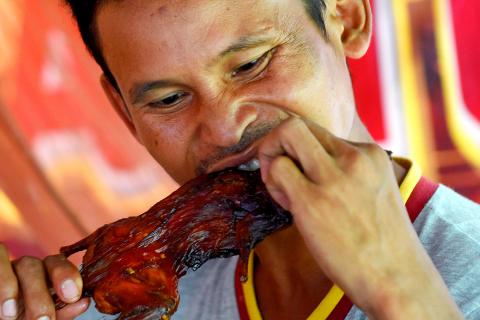As he tears off a leg of a charcoal-grilled rat at a roadside stall in western Cambodia, Yit Sarin hails the simple joy of rodent and rice washed down with beer.
“It’s delicious,” he says of the snack.
Barbecued field rats are not everybody’s idea of a tasty treat, but in Cambodia’s rural Battambang province they are popular as a quick — and cheap — snack, with small skewered ones going for US$0.25 each while larger rodents can cost US$1.25.

Photo: AFP
Rats were commonly eaten in the 1970s, under the ultra-Maoist Khmer Rouge, when frogs, tarantulas and other small creatures were considered fair game as a means to survive.
Now they are simply an inexpensive lunch for workers and farmers — though there is disagreement over what its meat tastes like. Sarin says that rat is like “chicken or beef,” whereas others say it’s more like pork. He is one of many customers and Cambodian tourists stopping at a stall outside of Battambang town, where rows of grilled field rats are displayed over burning coals and served with dipping sauces made from lime juice, black peppers or chillies.
Vendor Ma Lis says the snack has grown in popularity since she launched her stall more than a decade ago and sold just a few kilograms a day.
Today, she can net daily sales of around 20 kilograms, making brisk business from van-loads of travelling Cambodians and the occasional curious foreigner. The holiday season also spells bad news for the field rodents — Ma Lis can sell up to 180 large rats a day on the Cambodian New Year or water festival.
Dismissing any health concerns one might have about eating her unconventional treat, Ma Lis says her rodents are caught from rice fields and are good for you.
“These rats are healthier than pork and chicken... they eat lotus roots and rice grains,” she says, as she flips the barbecued bodies on the grill.
Despite the snack’s enduring appeal, many people remain squeamish.
“They feel it is disgusting,” she says, smiling.

May 26 to June 1 When the Qing Dynasty first took control over many parts of Taiwan in 1684, it roughly continued the Kingdom of Tungning’s administrative borders (see below), setting up one prefecture and three counties. The actual area of control covered today’s Chiayi, Tainan and Kaohsiung. The administrative center was in Taiwan Prefecture, in today’s Tainan. But as Han settlement expanded and due to rebellions and other international incidents, the administrative units became more complex. By the time Taiwan became a province of the Qing in 1887, there were three prefectures, eleven counties, three subprefectures and one directly-administered prefecture, with

It’s an enormous dome of colorful glass, something between the Sistine Chapel and a Marc Chagall fresco. And yet, it’s just a subway station. Formosa Boulevard is the heart of Kaohsiung’s mass transit system. In metro terms, it’s modest: the only transfer station in a network with just two lines. But it’s a landmark nonetheless: a civic space that serves as much more than a point of transit. On a hot Sunday, the corridors and vast halls are filled with a market selling everything from second-hand clothes to toys and house decorations. It’s just one of the many events the station hosts,

Among Thailand’s Chinese Nationalist Party (KMT) villages, a certain rivalry exists between Arunothai, the largest of these villages, and Mae Salong, which is currently the most prosperous. Historically, the rivalry stems from a split in KMT military factions in the early 1960s, which divided command and opium territories after Chiang Kai-shek (蔣介石) cut off open support in 1961 due to international pressure (see part two, “The KMT opium lords of the Golden Triangle,” on May 20). But today this rivalry manifests as a different kind of split, with Arunothai leading a pro-China faction and Mae Salong staunchly aligned to Taiwan.

Two moves show Taichung Mayor Lu Shiow-yen (盧秀燕) is gunning for Chinese Nationalist Party (KMT) party chair and the 2028 presidential election. Technically, these are not yet “officially” official, but by the rules of Taiwan politics, she is now on the dance floor. Earlier this month Lu confirmed in an interview in Japan’s Nikkei that she was considering running for KMT chair. This is not new news, but according to reports from her camp she previously was still considering the case for and against running. By choosing a respected, international news outlet, she declared it to the world. While the outside world